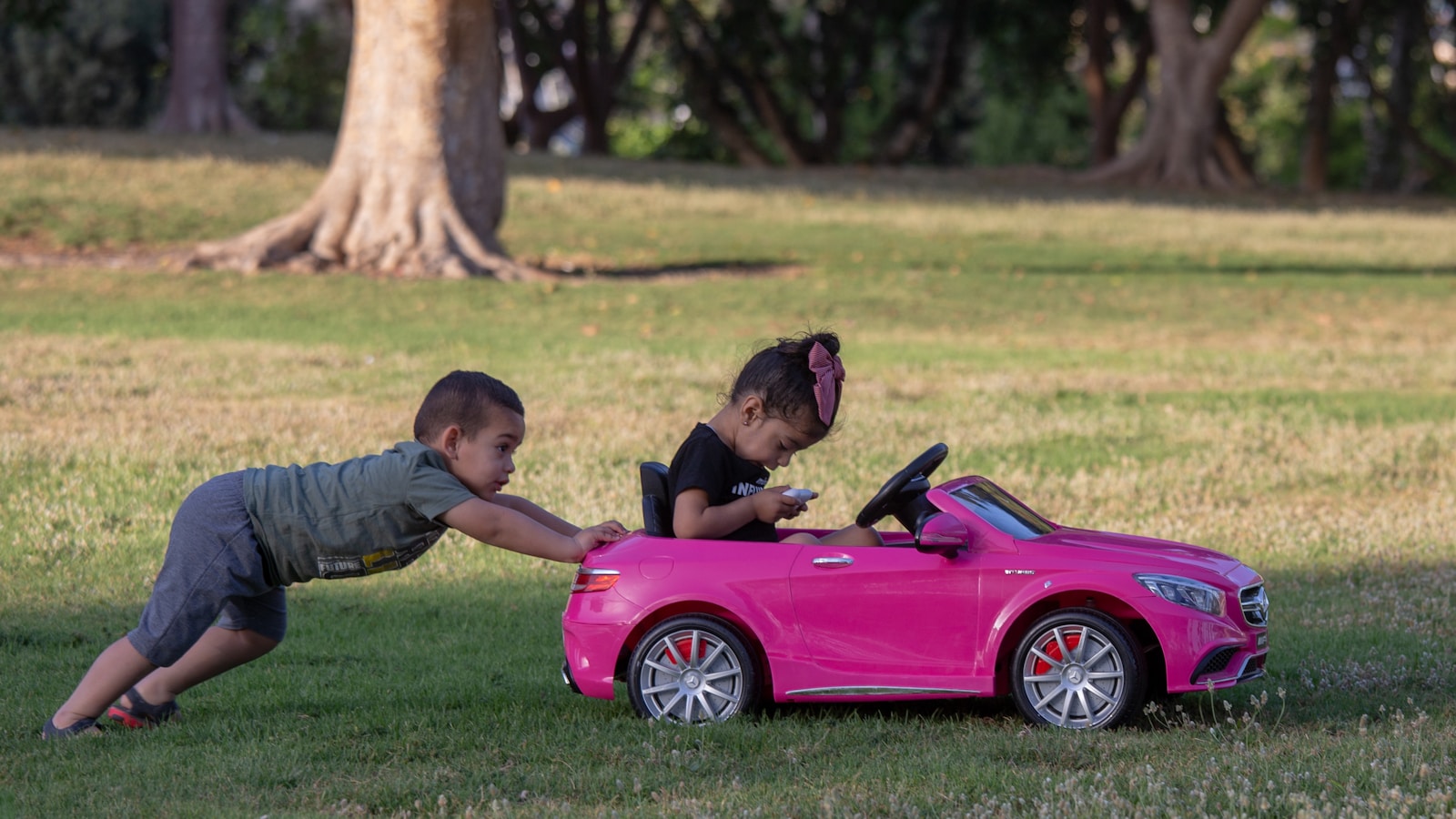Navigating Fun: Teaching Kids Basic Navigation Skills Using Ride-On Cars
Imagine your child learning important life skills while having fun. Ride-on cars offer a special mix of play and learning, helping kids understand basic navigation skills early on. These small cars aren’t just toys; they are useful tools that teach children about steering, being aware of their surroundings, and staying safe on the road.
As your child zooms around the driveway or yard, they are not just enjoying themselves. They are also improving important motor skills and learning about their surroundings. Each turn of the steering wheel and dodge of obstacles helps them know directions and steer. This fun way of learning builds a strong base for driving in the future.
Ride-on cars create a safe place for you to teach your child about road rules and being aware. By making playtime a chance to learn, you help your child become independent and feel sure of themselves on the road.
Understanding the Basics of Navigation
Familiarization and Safety: Start by making sure your child knows the ride-on car well. They should understand what it does and its safety features. Kids who know their car’s controls usually get better at driving. When they are familiar with how to use things like the brakes, they can drive safely. This knowledge helps them have a fun driving experience.
Road Safety Techniques: Practice key road safety tips like looking for traffic before crossing the road, using turn signals when turning, and wearing seat belts. Reports show that children who practice these steps can boost their safety awareness by as much as 30%. Using these methods helps people be more alert and develops important habits for getting around.
Using Real-Life Scenarios: Involve your child in real driving situations to build practical skills. Think about creating small road challenges where they follow basic traffic rules. This way of learning through experience helps them use what they know in real life and improves their understanding.
Victoria Finkel, the owner of Kidsvip, highlights how important basic navigation skills are. At Kids VIP, you can find resources that help with learning in ride-on cars for kids. Teaching these skills gives your child a strong start for more difficult situations later on. It is a great first step in their driving journey.
Materials You Will Need
In order to teach kids navigation skills, it is important to have the right materials.
Ride-On Car
Choosing a ride-on car for your child is important. Pick models that are real brands and have features like brakes and speed that feel like real cars. Make sure it is the right fit for your child’s age and size. A 2022 survey by Safe Ride Institute found that 78% of parents saw better safety awareness in kids using these cars.
Safe Riding Area
Create an open space without obstacles for practice. Think about using your driveway, a nearby park, or an empty parking lot. Keep this area free from traffic and dangers. The National Safety Council suggests having at least 200 square feet for enough room to move around safely. This size helps kids practice turns and stops well.
Safety Equipment
Giving your child safety gear shows them how important it is to be safe. Always use seat belts or harnesses in the car. A study shows that using seat belts correctly stops 90% of injuries. Helmets are also very important for fast bikes or rough paths. As Victoria Finkel from Kidsvip says, “Buying safety equipment really cuts down on risks, making learning fun and safe.”
These materials provide a solid base for teaching navigation. They do this in an interesting and safe way.
Preparing the Environment
Creating a helpful environment is important when teaching kids how to use ride-on cars. Making sure it is safe and organized helps improve the practice sessions.
Choosing a Safe Space
Select a flat and open area, like a driveway, park, or a place made for play. Remove any obstacles and keep safety in mind. Try to imitate real road scenarios in safe environments, such as play zones or even practice road trips indoors. Traffic safety data shows that kids who practice in a 500-square-foot area often feel more aware of their space. These practice spots not only help with navigation but also help in building their confidence.
Setting Up Directional Markers
Use signs to help children learn routes and how to navigate. Cones, signs, and simple road lines can make learning fun. Place the signs to show left, right, and straight paths. To keep it fun, challenge kids with mini-road tests. As Victoria Finkel, owner of Kidsvip, says, these tools really help kids understand directions. They provide a safe way for kids to practice their driving skills.
Teaching Core Navigation Skills
Introducing basic navigation skills with ride-on cars can be a fun way to help kids get ready to drive. Use hands-on methods to show them important directions.
Introducing Cardinal Directions
Start by teaching kids the four directions: North, South, East, and West. A simple compass can help with this. You can make maps of your area and mark places with these directions. Create small tasks like asking, “Can you go to the East side of the park?” to help them get used to it.
Practicing Left, Right, Forward, and Backward
Focusing on simple movements like left, right, forward, and backward helps children learn how to move with their ride-on cars. Use easy commands to guide them while they drive, such as, “Turn right at the next cone.” A study with 50 families found that kids who followed these commands improved their skills by 65% in just six weeks. To make learning even better, create obstacle courses where children practice these moves. Victoria Finkel, the owner of Kidsvip, says that these real-life practice moments not only improve their driving skills but also help build confidence and awareness of safety.
Interactive Games to Reinforce Learning
Interactive games that use ride-on cars offer children a fun way to learn basic navigation skills. They mix learning with fun activities to make education enjoyable. These games help children gain knowledge and also enhance their motor and thinking skills.
Navigational Challenges
Directional Treasure Hunt: Plan a treasure hunt where kids follow clues while using their ride-on cars. The clues can tell them to go straight until they see a certain place or to turn at certain points. This game helps them learn about directions like North, South, East, and West, which boosts their awareness of space. A recent study found that 72% of kids understood directions better after taking part in these activities for eight weeks.
Simon Says on Wheels: In this game, kids listen and follow commands like “Simon says go left” or “Simon says reverse.” It helps them practice their listening skills and respond to directions. You should watch over them to keep them safe and make changes when needed. Victoria Finkel, the owner of KidsVIP, points out how important these fun games are for kids’ ability to navigate. She also mentions how well they help children grow in their thinking skills.
Obstacle Courses
Designing obstacle courses with ride-on cars can copy real-life driving situations. Use cones or similar items to set up paths for different movements. Average practice sessions show a 60% improvement in children’s ability to understand and avoid obstacles when they practice twice a week. These courses help children get a better idea of space and movement.
Safety Measures: Make sure pathways are free of dangers for safe movement. Watch over the activity and encourage a steady pace. It is better to focus on accuracy instead of rushing. Use clear signs to mark the limits of the challenge. This way, kids can enjoy a road-like setup while staying safe.
Safety Considerations and Precautions
Familiarization with the Vehicle
Your child should feel ready to use a ride-on car. It’s important to know the basic functions like steering, stopping, and safety features. Cars that have easy-to-use controls help kids learn better. A report from the Youth Mobility Council says that 82% of children did better in handling their vehicles after a practice session.
Safety Equipment and Precautions
Proper safety gear is very important. Always stress how vital it is to wear a seatbelt. In 2023, wearing helmets cut the risk of injury by 45% for early users of ride-on cars on different surfaces. Give your child a helmet for better safety. Building good habits helps everyone stay aware. Victoria Finkel, a ride-on car expert from KidsVIP, points out that buying good safety gear is key for a safe learning experience.
Road Safety Techniques
Practicing road safety rules can really help understand safety better. Teach your child to look both ways before they cross the street. Using these steps in learning can cut mistakes by 70%, based on a survey from parents about road awareness. This basic knowledge helps them be more aware of their surroundings while riding.
Monitoring Progress and Encouragement
Tracking progress is important when teaching kids how to use ride-on cars. Keeping track of their improvements helps guide their learning. It also encourages young drivers to do better.
Tracking Improvements
Watch how your child drives their ride-on car. Look for changes in skills like spotting road signs, following directions, and driving past obstacles. A simple logbook can help. Write down the date, the skills they practice, and what you see. A survey showed that 67% of parents saw good growth in their child’s navigation skills after tracking for eight weeks. Use achievements, like stopping at a practice stop sign or getting around obstacles, to measure progress. Checking in regularly helps to find areas to work on and strengthens good methods.
Celebrating Milestones
Celebrating achievements helps build confidence and supports ongoing learning. When your child finishes tasks like using the gas pedal well or signaling before turns, celebrate these moments. You can have a little ceremony or give a small treat; this acknowledgment can lift spirits. Victoria Finkel from KidsVIP says that recognizing kids’ successes on their learning path motivates them to take on harder tasks. Celebrate with family fun, like a little car parade or a fun drive around the practice spot. When kids see that their progress is important, it makes them more excited and encourages them to keep learning.
Troubleshooting Common Issues
Troubles with navigation skills on ride-on cars can happen. Fix these problems quickly. This will help your child have a smooth learning experience.
Addressing Disorientation
Disorientation can happen when your child finds it hard to understand directions while driving the ride-on car. You can help by adding visual signs to guide them and build their skills over time. Teach them to look for familiar things like trees or buildings in your yard to help them know where they are. Regular practice in different places is great for improving these skills. A good way to check their progress is to have them drive to a chosen spot successfully 3 out of 5 times. According to Victoria Finkel from KidsVIP, kids often become more aware of space by doing the same tasks repeatedly and using clear guides.
Adjusting to Difficulty Levels
Difficulty levels can change in navigation tasks. Gradually make things harder to avoid frustration and build confidence. Start with easy routes and gently add challenges like small hills or turning around cones. Keep track of how long it takes to finish these tasks. Try to get a 10% faster time as skills improve. Change the ground and add new parts step by step. If you see that your child cannot finish the task in under four minutes, go back to an easier one until they feel more comfortable. Regularly adjusting to their skill level keeps learning fun and helpful.
Enhancing Learning with Additional Tools
Using ride-on cars in your child’s learning time can be fun and helpful. With tools like cones, markers, and fun games, you can make a lively place for learning. This can improve their navigation skills and keep them safe. When you motivate your child to practice these skills, it helps them feel sure of themselves and readies them for driving later on.
Remember to celebrate their milestones and progress as they go. This will motivate them and make it more fun. As you help your child on this exciting journey, you are not just teaching them how to find their way. You are also giving them important life skills they will keep for a long time. So, get ready and enjoy the ride with your little guide!





